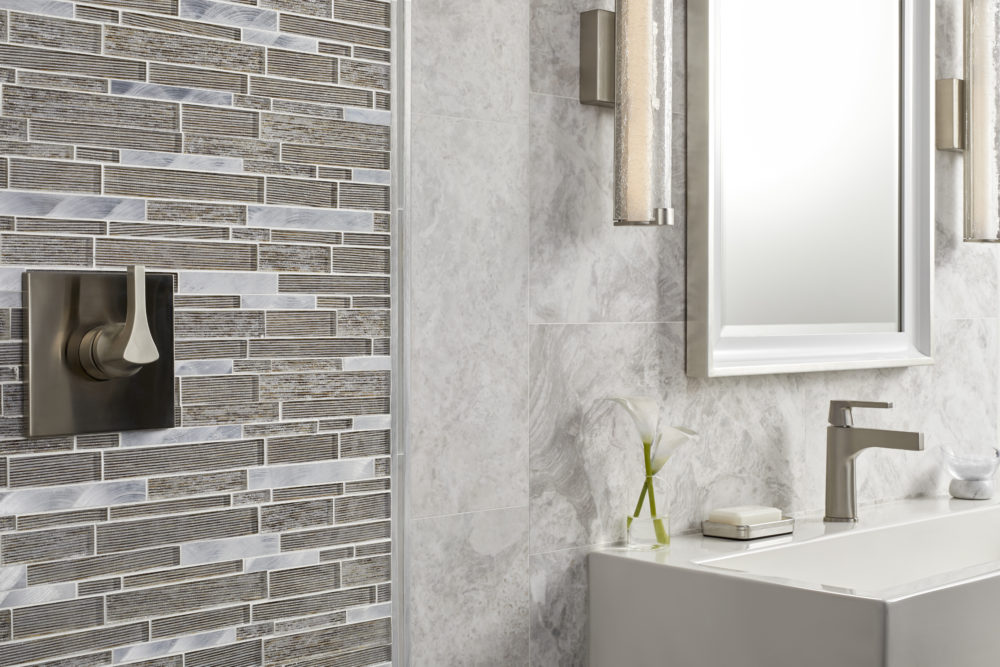Tile 101
Guide to Tile Finishes
Different shapes, sizes, materials, finishes—the variety of attributes that can change the appearance of a tile (and, in turn, your space) are almost limitless. But we’ve seen a few tiles in our day and are here to make sense of it all for you. Before you start your next project, refer to this handy guide to tile finishes.
Types of finishes
Finishes, or different effects on the surface of a tile that alter its appearance, are generally divided into ceramic, porcelain and other man-made tiles vs. stone categories because of the different ways the materials can be treated. First, we’ll explore the processes that define stone finishes and then look at man-made tiles.
Stone
Stone tile with a polished finish has been passed under a series of polishing wheels with increasingly finer pads using water and polishing compound to assist in the process. This results in a smooth and shiny tile, perfect for adding a touch of luxury and glamour to formal and traditional spaces. Marble is a one type of stone that is often polished.


Satin finishes are produced through the same process as polished but using fewer polishing wheels. This lends a softer and less shiny appearance to the tile, the perfect balance between polished and honed.

Honed tiles go through the same process as polished and satin but with even fewer wheels that result in a smooth matte finish. This is the most casual finish of the three, reflecting very little light and contemporizing a design.


For a brushed finish, stone is run under wheels with metal bristles to achieve an orange peel-like finish. Benefits of a brushed tile are that its texture provides softness, it handles wear and tear and has a relaxed character.

To obtain a tumbled finish, tiles are put into large drums filled with aggregate and shaken. The aggregate wears down the surface of the stone, giving it a rough surface and more rounded edges. Tumbled stones offer increased traction, hide imperfections and flawlessly coordinate with rustic décor.


We’re going au naturel with this one. With natural finish stone tile, what you see is what you get. Nothing is done to the surface of these tiles, and, besides being cut to size, they’re just like they looked when they were quarried. Natural tiles give an authentic and outdoorsy look to your space. Slate is a common example of a natural finish stone.


Filled and unfilled are not exactly finishes, but they alter the surface of a tile so they’re worth mentioning and defining here. Filled stone has its natural crevices and holes filled with an epoxy resin mixed with stone dust in a color that closely resembles the stone’s natural color. This makes the tile easier to clean and install. Unfilled stone is left in its natural state, voids and all. This allows you to choose to fill it with the grout color of your choice or leave it in its rustic, raw state for a unique look.
Here, you can see the difference in appearance of an unfilled travertine compared to a filled travertine. Bucak Silver Honed Unfilled Travertine, on the left, has visible holes and crevices on its surface, whereas Bucak Light Walnut Honed Filled Travertine, on the right, has a lighter colored compound filling in these areas.


Ceramic and Porcelain

Polished tiles are double fired, first with the desired pattern or color and then with a clear coat. Afterwards, they go through the same polishing process as stone, passing under polishing wheels with water and polishing compound. Lastly, the tiles are sealed to retain their appearance. Stone-look porcelain or ceramic tiles are often in polished finishes to mimic the look of natural stone.

A glossy finish is different from polished in that it is created with a glossy glaze instead of a polishing wheel process. Depending on the texture of the tile, gloss glazes can pool in areas, creating thicker and thinner areas of glaze and variations in coloring.

Matte tiles are covered in a non-shiny glaze that is applied with an ink jet machine or in a waterfall stream glazing method. This process yields tiles with a flat finish that do not reflect light and offer a contemporary look.

Multifired tiles are one of the most exciting technological advancements in the industry in recent years. They’re so interesting, we devoted a whole blog post to them! These are tiles that go through more than two firings in a kiln, usually to give them 3-D texture, metallic finish or another interesting effect that is not possible with just one or two firings.

An anti-slip surface is perfect for tiling in wet areas like bathrooms, entryways or mudrooms. They’re also great if aging in place is a consideration in your home. A fine grit or sand is added to a matte glaze to create a rough, gripping texture on the tile.

Textured tile is made by pressing materials into a mold that give a textured effect, such as that of natural stone or wood. Then it’s glazed and fired to achieve the desired look. The below tile is actually a porcelain that has been textured to look like a tumbled stone.

Congratulations! You’ve just completed a crash course in natural stone and man-made tile finishes. If your head is spinning, don’t worry. Our tile experts are waiting in your local store to help you design your next project and choose your perfect tile. Schedule a design consultation or stop in today.